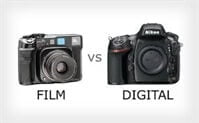
Digital film is any storage medium (such as a memory card, diskette, or recordable CD) used in a digital camera to capture and store images. A digital camera may require a particular type of storage medium or maybe compatible with a number of different types.
The sensor: The most obvious difference between film and digital is the sensor used to take the photo. With film cameras, a film sensitive to light is placed behind the lens. … With digital cameras, a fixed electronic sensor (sometimes known as CCD) is situated behind the lens.
Digital cinema refers to the use of digital technology to distribute or project motion pictures as opposed to the historical use of reels of motion picture film, such as 35 mm film. … Digital movies are projected using a digital video projector instead of a film projector.
Is a 70mm film better than digital?
However, high-format celluloid films (70mm) have relatively comparable, if not better, resolution than high-definition digital films. There is also an authentic edge to old-school cinematography, which is often lost in the glossy, sterile, and polished appearance of digital projection.
Does film look better than digital?
Film photos look better than digital photos. Film photography will always look better than digital photography, period. The best digital photos are the ones that simulate the look of film. … VSCO is making presets to make clinical and soulless digital photos have life— by adding grain, randomness, and softer colors
Do cinemas use film or digital?
No, film projection is a thing of past now. Not only in the US, but in most of the countries around the world, the projection system has gone digital with the age. Nowadays, most of the theatre chains use digital projectors and movies are distributed to them in magnetic hard drives
Yes. Many pro photographers still use film. The reasons are many and vary by the individual. A lot of landscape photographers use large-format view cameras and sheet film still because there are very few digital cameras that can approach the sheer resolution of a 10″x8″ frame
Advantages of digital over film.
There’s no question that film is still the gold standard to which all digital formats are held to. It still delivers a type of character that is beautifully flawed and organic in a way that digital never will be. But even still, there are some instances where digital is simply the better choice. Here are just a handful of examples of when that’s the case.
1. Low Light
Filmmakers that came up during the digital revolution very much take for granted the low-light capabilities of digital cameras. Standard film stocks often are rated anywhere from ISO 100 to ISO 800, with 1600 and 3200 being options as well (although less common). That said, just about any professional digital cinema camera (or DSLR for that matter) can shoot at much higher settings with far cleaner results.
There is simply no film equivalent to cameras like the 7S 11 or the C 300. There is no film stock that will allow you to shoot without any lights and still get noise-free results. Naturally, shooters that need to work with limited lighting are going to be drawn to digital formats.
2. Cost and Time on Set
Even if you’ve never shot on film, chances are you’re well aware of the costs associated with going down that path. While film cameras are cheaper than ever to buy (or rent), film stocks and processing are still quite expensive and very prohibitive for low-budget filmmakers.
And even in cases where an indie production is able to scrape together enough budget to shoot on film, there can be other ramifications while on set. More specifically, productions will need to shoot at a lower ratio (perhaps only getting two or three takes per shot) in order to conserve their film stock.
3. Turnaround Time
Many of us have taken for granted the fact that there is virtually no turnaround time when processing your digital dailies. In some cases, productions now will even opt to have an editor working on set who will create assembly cuts of scenes as the rest of the crew is still shooting.
It goes without saying that this certainly isn’t the case with film. When shooting on film, it will take several days (or weeks) to get your processing/scanning done, and only then will you be able to move ahead on the edit. Not to mention, if there are any issues with the footage, you will need to schedule a pickup day. Unlike digital, you wouldn’t have been able to know on set.
4. Longer Takes
Any directors today have come around to the digital format simply because it allows for long (or virtually unlimited) record times. Again, this is something that digital shooters without film experience very much take for granted. Veteran filmmakers, however, can’t deny the fact that having the ability to record indefinitely opens up a lot of creative possibilities.
A standard 1000 foot roll of 35mm motion picture film will only give you about 11 minutes, which isn’t a whole lot. This isn’t always going to be an issue, considering that the vast amount of takes on any given productions will
Digital filmmaking is the norm these days, enabling filmmakers to blend art and digital media and speed up the process of filmmaking as well as be more creative and enterprising in the special effects department.
In short, more flexible digital cameras—such as the Panasonic HVX 200 and the RED One and Scarlet cameras—and editing software such as Final Cut Pro Studio, have made the cinematographer’s and editor’s jobs easier and made it possible for filmmakers to produce quality films at much less expensive cost.
What this means for film students is that breaking into the industry isn’t just less expensive, but getting your work out there is easier too.
Advantages of Digital Filmmaking
Even big blockbuster films are using digital. While the first two films in “The Hunger Games” series were shot on 35mm and 65 mm (IMAX), and Christopher Nolan’s epic “Dunkirk” was shot on 65mm, “The Hunger Games: Mocking Jay, Parts 1 and 2” are shot using digital, and more and more movies embrace digital as the norm, not the exception. David Fincher’s “Gone Girl” is the first feature film to be shot with the Red Dragon sensor, which can pull high-quality still images from video. Subsequent films using Red include “Captain Marvel” and Danny Boyle’s “Yesterday.”
Here are some plusses to digital filmmaking:
- Digital filmmaking is accessible. Relatively low cost and user-friendly, digital recording equipment is the personal computer of the film industry. While this could be seen as a threat to the establishment, these new voices in the film can also inspire others and bring new energy to the film industry.
- Editing is simple. Like digital recording equipment, editing equipment for digital film is affordable and also easy to master. Postproduction can be less cumbersome in the digital world. If someone with no training in digital film editing can do a reasonable job on their Mac, imagine what someone with digital filmmaking career training could do.
- Digital distribution reaches a wide audience. You no longer need a big marketing budget to reach a wide audience. Today, your movie could take off on YouTube. Digitally formatted films aren’t bound to traditional distribution methods. A little success could open big doors for your film career.
- Digital projection saves money. The cost to make and ship a 35mm print is approximately $1,500 while the cost to make a hard drive containing a digital movie is $150. A digital print won’t break or scratch and the format presents the ability for theaters to show alternate programming, such as live theater and opera.
With movie studios theatrically distributing their films in the digital format, the burden will fall on theaters to convert their platter projection systems to digital. Otherwise, the only films they’ll be able to screen are art house and classic repertory older movies, which could be critical to smaller theater owners.
Run less than 11 minutes. But for directors will a specific type of approach on set, this can be a negative.
Final Thoughts
Despite all of these points, I still believe film is the most beautiful-looking format out there and an ideal choice for so many higher-end productions. It will exist for many years to come if only to service some of the top filmmakers on the planet who refuse to shoot digitally. But even still, there is no denying that digital can trump film in certain regards, especially from a practicality standpoint, and the quality level of digital cinema is now stronger than ever. While shooting digitally was once considered taboo by professional filmmakers, it’s now officially the status quo and will inevitably only improve more with time.







